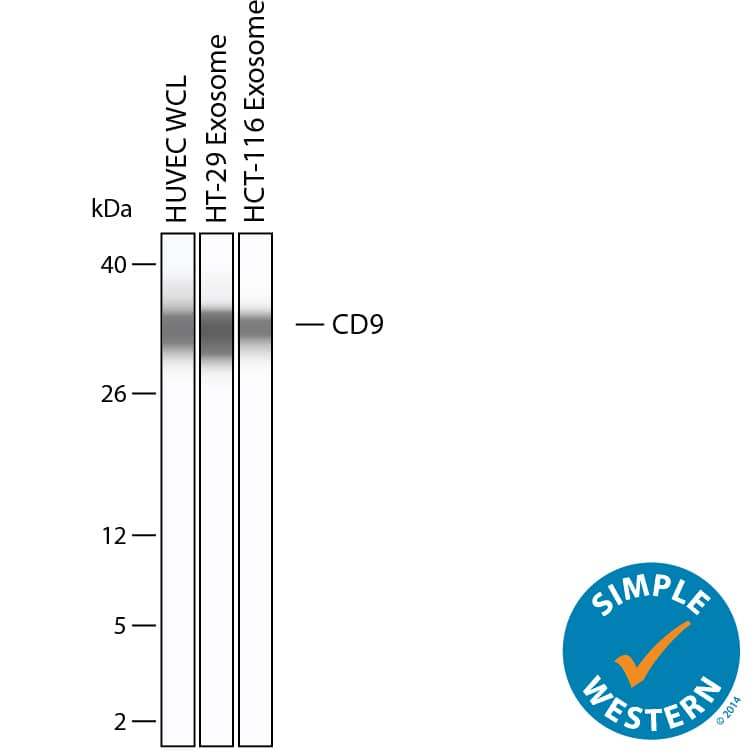Human CD9 Antibody
R&D Systems, part of Bio-Techne | Catalog # MAB11464
Recombinant Monoclonal Antibody.

Key Product Details
Species Reactivity
Human
Applications
Simple Western, Western Blot
Label
Unconjugated
Antibody Source
Recombinant Monoclonal Rabbit IgG Clone # 2665FF
Product Specifications
Immunogen
Chinese Hamster Ovary cell line, CHO-derived human CD9
Ser112-Ile195
Accession # P21926
Ser112-Ile195
Accession # P21926
Specificity
Detects human CD9 in direct ELISAs.
Clonality
Monoclonal
Host
Rabbit
Isotype
IgG
Scientific Data Images for Human CD9 Antibody
Detection of Human CD9 by Western Blot.
Western Blot shows lysates of HUVEC human umbilical vein endothelial cells and HCT-116 human colorectal carcinoma cell line. PVDF membrane was probed with 2 µg/ml of Rabbit Anti-Human CD9 Monoclonal Antibody (Catalog # MAB11464) followed by HRP-conjugated Anti-Rabbit IgG Secondary Antibody (Catalog # HAF008). A specific band was detected for CD9 at approximately 23 kDa (as indicated). This experiment was conducted under reducing conditions and using Western Blot Buffer Group 1.Detection of Human CD9 by Simple WesternTM.
Simple Western shows lysates of HUVEC human umbilical vein endothelial cell line whole cell lysate (WCL), Exosome Standards (HT-29 cell line) (NBP3-11685) and Exosome Standards (HCT-116 cell line) (NBP2-49854), loaded at 0.5 mg/ml. A specific band was detected for CD9 at approximately 33 kDa (as indicated) using 50 µg/mL of Rabbit Anti-Human CD9 Monoclonal Antibody (Catalog # MAB11464) followed by 1:50 dilution of HRP-conjugated Anti-Rabbit IgG Secondary Antibody (Catalog # HAF008). This experiment was conducted under non-reducing conditions and using the 2-40kDa separation system.Applications for Human CD9 Antibody
Application
Recommended Usage
Simple Western
50 µg/mL
Sample: HUVEC human umbilical vein endothelial cell line whole cell lysate (WCL), Exosome Standards (HT-29 cell line) (NBP3-11685) and Exosome Standards (HCT-116 cell line) (NBP2-49854)
Sample: HUVEC human umbilical vein endothelial cell line whole cell lysate (WCL), Exosome Standards (HT-29 cell line) (NBP3-11685) and Exosome Standards (HCT-116 cell line) (NBP2-49854)
Western Blot
2 µg/mL
Sample: HUVEC human umbilical vein endothelial cells and HCT-116 human colorectal carcinoma cell line
Sample: HUVEC human umbilical vein endothelial cells and HCT-116 human colorectal carcinoma cell line
Formulation, Preparation, and Storage
Purification
Protein A or G purified from hybridoma culture supernatant
Reconstitution
Reconstitute at 0.5 mg/mL in sterile PBS. For liquid material, refer to CoA for concentration.
Formulation
Lyophilized from a 0.2 μm filtered solution in PBS with Trehalose. *Small pack size (SP) is supplied either lyophilized or as a 0.2 µm filtered solution in PBS.
Shipping
Lyophilized product is shipped at ambient temperature. Liquid small pack size (-SP) is shipped with polar packs. Upon receipt, store immediately at the temperature recommended below.
Stability & Storage
Use a manual defrost freezer and avoid repeated freeze-thaw cycles.
- 12 months from date of receipt, -20 to -70 °C as supplied.
- 1 month, 2 to 8 °C under sterile conditions after reconstitution.
- 6 months, -20 to -70 °C under sterile conditions after reconstitution.
Background: CD9
References
- Shi, W. et al. (2000) J. Cell Biol. 148:591.
- Hemler, M. (2003) Annu Rev Cell Biol. 19:397.
- Hulme, R. et al. (2014) PLoS One 9:e116289.
- Stipp, C. et al. (2003) Trends Biochem Sci. 28:106.
- Barreiro, O. et al. (2005) Blood 105:2852.
- Ventress, J. et al. (2016) PLoS One 11:e0160387.
- Rubinstein, E. (2011) Biochem Soc Trans. 39:501.
- Anzai, N. et al. (2002) Blood 99:4413.
- Radford, K. et al. (1996) Biochem. Biophys. Res. Commun. 222:13.
- Lozahic, S. et al. (2000) Eur. J. Immunol. 30:900.
- Park, K. et al. (2000) Mol. Hum. Reprod. 6:252.
- Charrin, S. et al. (2001) J. Biol. Chem. 276:14329.
- Tachibana, I. et al. (1997) J. Biol. Chem. 272:29181.
- Zhu, G. et al. (2002) Development 129:1995.
- Green, L. et al. (2011) Infect Immun. 79:2241.
- Powner, D. et al. (2011) Biochem. Soc. Trans. 39:563.
- Detchokul, S. et al. (2014) British Journal of Pharmacology 171:5462.
- Reyes, R. et al. (2018) Front. Immunol. 9:863.
- Slupsky, J. et al. (1989) J Biol chem. 264:12289.
- Ishibashi, T. et al. (2004) J. Neuroscience 24:96.
- Kobayashi, H. et al. (2004) Clin Exp Immunol. 137:101.
Alternate Names
CD9, DRAP-27, MIC3, p24, TSPAN29
Gene Symbol
CD9
UniProt
Additional CD9 Products
Product Documents for Human CD9 Antibody
Product Specific Notices for Human CD9 Antibody
For research use only
